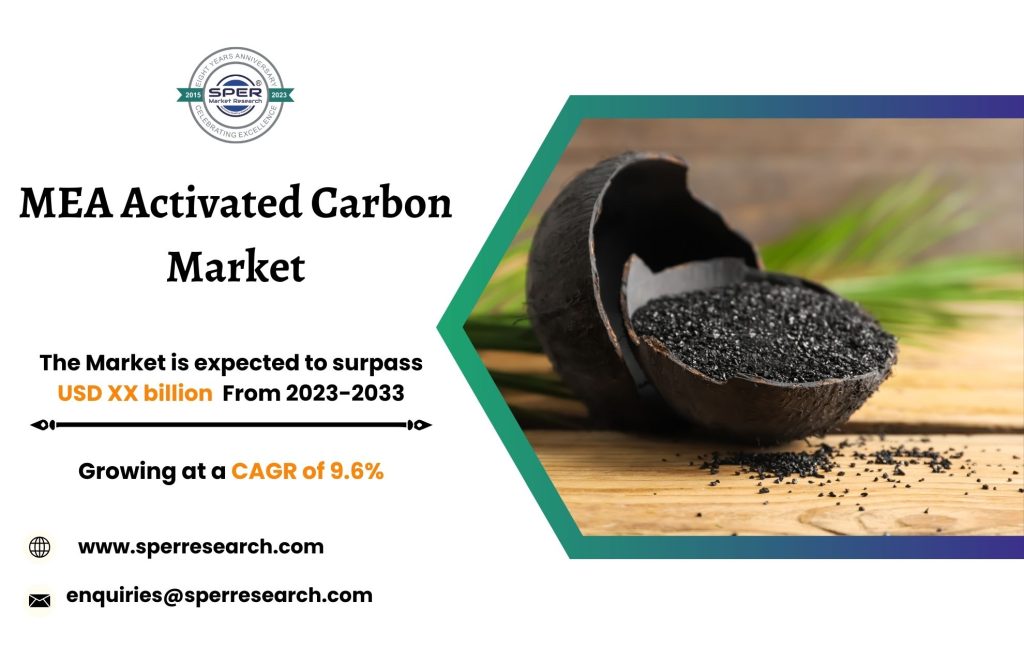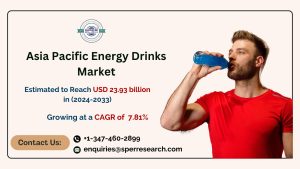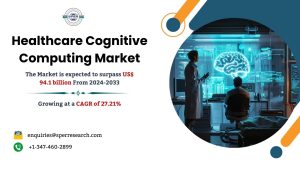Small, low-volume pores on processed carbon are used to create activated carbon, which increases surface area for adsorption and chemical reactions. High carbon organic material is processed to create activated carbon. The primary characteristic of activated carbon is physical adsorption, which makes it beneficial for fuel storage, metal finishing, medication, filters, decaffeination, and purification. Activated carbon’s applications in eliminating lead, mercury, dissolved radon, and other odor-causing substances are improved by its liquid and gaseous phases.
According to SPER market research, Middle East and Africa Activated Carbon Market Size- By Product Type, By Raw Material, By Phase, By End Use – Regional Outlook, Competitive Strategies and Segment Forecast to 2033’state that the MEA Activated Carbon Market is predicted to reach USD XX Billion by 2033 with a CAGR of 9.6%.
Demand for activated carbon products is increasing throughout the Middle East and Africa (MEA), driven by urbanisation, population expansion, and rising environmental consciousness, particularly in the water treatment and air purification industries. Many MEA manufacturers prioritise sustainability, which includes using renewable resources, lowering energy consumption, and minimising waste. This reflects the region’s increased emphasis on sustainable development and environmental issues. Water shortage drives the demand for water treatment products, including activated carbon, which is often used to remove pollutants, organic compounds, and odours from water. To guarantee product quality and safety, governments in the MEA region enforce import/export laws as well as health and safety requirements for the manufacture of activated carbon. In addition, MEA governments manage the integrity of water resources and work towards lowering carbon emissions; carbon capture and storage technologies use activated carbon in these systems.
Activated carbon prices in the MEA market are volatile and can affect the competitiveness of products due to changes in energy, raw material, and transportation costs. This makes planning and budgeting for the product difficult. Moreover, enterprises’ efforts to market their products and grow their client base are hampered by a lack of knowledge about its advantages in various MEA regions. Regulations that are too stringent in some nations, slowing approval processes and driving up prices, make it harder to enter certain markets. Exploration of novel applications and product development in the activated carbon sector are further limited by the region’s low level of R&D activities.
Request For Free Sample Report @ https://www.sperresearch.com/report-store/mea-activated-carbon-market.aspx?sample=1
Impact of COVID-19 on MEA Activated Carbon Market
Due to supply chain interruptions, a decline in industrial activity, and a decline in demand, the COVID-19 pandemic affected the Middle East and Africa activated carbon market. The region’s market’s growth trajectory was impacted by lockdown measures and economic slowdowns, which hindered demand in critical areas including air and water purification.
The United Arab Emirates, Saudi Arabia, and South Africa are the three main countries that dominate the activated carbon market in the Middle East and Africa. Saudi Arabia is a notable user of activated carbon due to government rules encouraging its usage in a variety of industries, most notably water treatment, which is overseen by the Saudi Arabian Standards Organisation (SASO). Saudi Arabia is home to several domestic and foreign producers of activated carbon, creating a competitive market. South Africa contributes significantly as well, reaping the rewards of a strong mining industry that guarantees a consistent supply of raw materials for the manufacturing of activated carbon, which is used in chemical processing, mining, and water treatment. Furthermore, the United Arab Emirates (UAE) is a significant market, home to a large number of manufacturers of activated carbon that service applications including water treatment, air purification, and chemical processing.
GCC Activated Carbon Market Key Player
Additionally, some of the market key players are Advanced Emissions Solutions Inc, Albemarle Corporation, Boyce Carbon, Osaka Gas Co Ltd, Puragen Activated Carbons, Veolia Water Technologies, Others.
Middle East and Africa Activated Carbon Market Segmentation:
The SPER Market Research report seeks to give market dynamics, demand, and supply forecast for the years up to 2033. This report contains statistics on product type segment growth estimates and forecasts.
By Product Type: Based on the Product Type, Middle East and Africa Activated Carbon Market is segmented as; Extruded or Pelletized Activated Carbons, Granular Activated Carbons, Powdered Activated Carbons, Others.
By Raw Material: Based on the Raw Material, Middle East and Africa Activated Carbon Market is segmented as; Coal Based, Coconut Shell Based, Wood Based, Others.
By Phase: Based on the Phase, Middle East and Africa Activated Carbon Market is segmented as; Gas Phase, Liquid Phase.
By End Use: Based on the End Use, Middle East and Africa Activated Carbon Market is segmented as; Air Purification, Automotive, Food & Beverage Processing, Pharmaceutical & Medical, Water Treatment, Others.
By Region: This research also includes data for Saudi Arabia, South Africa, The United Arab Emirates, Turkey and rest of Middle East & Africa.
This study also encompasses various drivers and restraining factors of this market for the forecast period. Various growth opportunities are also discussed in the report.
For More Information, refer to below link:-
MEA Activated Carbon Market Revenue
Related Reports:
Follow Us –
LinkedIn | Instagram | Facebook | Twitter
Contact Us:
Sara Lopes, Business Consultant – U.S.A.
SPER Market Research
+1-347-460-2899



